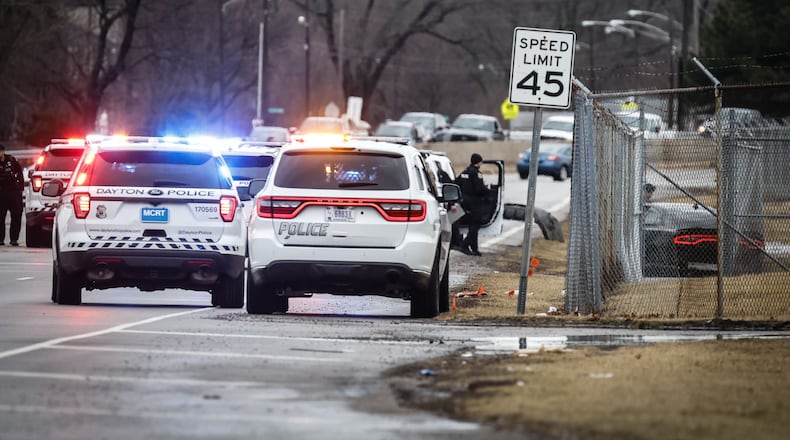“The operation of a police vehicle in response to an emergency or in pursuit of another vehicle is the most hazardous situation routinely confronted by a police officer,” said Lt. Eric Sheldon, commander of the Dayton Police Department’s Professional Standards Bureau.
Credit: Jim Noelker
Credit: Jim Noelker
Car crashes and traffic-related incidents are one of the leading causes of injuries and death among U.S. law enforcement officers, and police chases are fraught with risk, especially when they reach high speeds.
But police say chases are sometimes necessary to apprehend dangerous suspects, and the police department has many rules about when officers can go after fleeing vehicles.
Drivers fled from Dayton police 526 times last year, which was up nearly 2% from 2020, department data show.
Dayton officers took part in 58 chases — a 66% increase from 2020.
In the last four years, motorists fled from Dayton officers on nearly 2,000 occasions and police were involved in more than 175 pursuits.
Officers during that time period also were involved in 235 separate automobile crashes.
Police pursuits often stem from gun-reduction initiatives in which officers target high-crime areas and try to apprehend criminal suspects associated with firearms and drug offenses, said Sheldon.
“People with large amounts of drugs in their car don’t want to stop for police,” he said.
The initiatives are meant to reduce gun, drug and shooting-into-habitation offenses by “saturating” pre-determined target locations, police said.
Police pursuits most commonly take place when a crime is in progress, Sheldon said, but chases often are initiated when officers receive broadcasts about suspects or suspect vehicles.
The safety of citizens and officers is the first concern in a pursuit, Sheldon said, and officers and supervisors must be able to articulate why they engaged in a chase.
A few years ago, a Dayton police lieutenant on routine patrol spotted a vehicle matching the description of one belonging to a felony suspect, according to appellate court records.
The suspect had robbed and attacked an 80-year-old property manager, and the police lieutenant followed the car along Riverside Drive as another officer put down stop sticks.
As the suspect approached the sticks, the lieutenant activated his sirens and lights, but the suspect fled, at times driving 70 miles per hour, and he ran a red light and crossed into the oncoming traffic lane.
The officer in pursuit used the front of his cruiser to hit rear part of the fleeing vehicle, causing it to spin out. The suspect fled on foot, but was found hiding in the woods, and he was convicted of felonious assault and aggravated robbery.
Dayton Police Department regulations say pursuits are reasonable when failure to apprehend the suspect immediately poses a clear and present threat to law enforcement and others.
Officers also can give chase if there is probable cause to believe the suspect committed various felony offenses.
Officers are required to terminate pursuits when the risks of pursuit to officers and the public outweigh the dangers to the community if the fleeing driver is not apprehended.
Police also can give chase when suspects intentionally strike people or occupied vehicles; suspects steal police vehicles; and pursuing officers have probable cause to believe suspects have kidnap or abduction victims.
Police officials say the department has a restrictive pursuit policy because of the safety risks to the community.
“They are dangerous for the community, the general public that are just out there driving,” Dayton Police Lt. Col. Eric Henderson said last year. “They are dangerous for the officers that are engaged with them and they are dangerous for the suspect because it increases the likelihood of something tragic occurring.”
Of the 58 vehicle chases in 2021, eight ended with suspects crashing their vehicles.
Patrol and traffic duties also pose threats to law enforcement.
Last year, officers were in 43 automobile crashes, four of which led to an officer injury.
Officers were determined to be at fault for about half of the collisions (21), department data show, and officers who were at-fault received training memorandums or reprimands for policy violations.
About the Author



